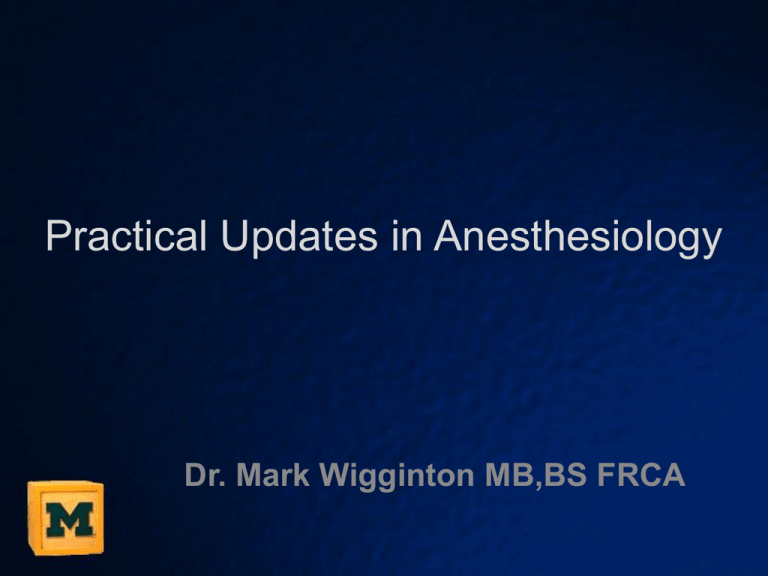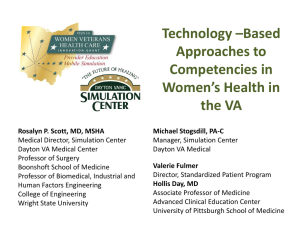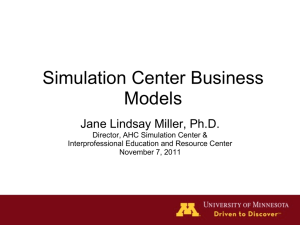Fall and Rise of Simulation - UM Anesthesiology
advertisement

Practical Updates in Anesthesiology Dr. Mark Wigginton MB,BS FRCA The Fall & Rise of Simulation Anatomical models • Anatomical stone sculpture from 24,000 years BC • Egyptian • Mayan • 18th & 19th century memento mori • Song dynasty – Wang Wei-Ye (987-1067) De Humani Corporis Fabrica Libri Septum by Andrea Vesalio 1543 Interactive models • 1739 British maternity hospital opens with a promise, – “all the inconveniences which might otherwise happen to women from pupils practising too early on real objects will be entirely prevented: for by this method and contrivance each pupil will become in a great measure proficient in his business before he attempts a real delivery.” • Giovanni Antonio Galli • Dr. Ozenne • Marguerite Le Boursier du Coudray Angélique Margeurite Le Boursier du Coudray 1714 -1789 ‘The Machine’ – Musée Flaubert et d'Histoire de la Médecine, Rouen The Flexner Report Facilities for teaching Obstetrics in US Hospitals - 1909 • Southwestern University Medical College, Texas – “in the corner of one [lecture room] is an abused manikin.” • Georgia College of Eclectic Medicine & Surgery, Georgia – “limited to a tattered manikin.” Commenting on medical training institutions • Of the four institutions in the state of Texas only one was felt, “capable of maintaining a medical school whose graduates deserve the right to practice among its inhabitants.” • “Those who deal with medical education in Tennessee are therefore making the worst, not the best, of their limited possibilities.” • Portland and Salem, Oregon, “Neither of these schools has either resources or ideals; there is no justification for their existence.” • University of Michigan Department of Medicine & Surgery, “There is no question that if the entire state university were at Detroit, the medical department would be better off.” – “A faculty of distinction, with a hospital well equipped for the care of the sick, and for teaching and research, can successfully overcome the most serious difficulties of the situation.” Sim One Laerdal Simulation manufacturers • • • • Laerdal CAE Healthcare (formerly METI) Gaumard Simulab • Improvised & local adaptations Current Simulation Technology for Anesthesia • Task trainers • Low fidelity mannequins • High fidelity mannequins Blue Phantom Pediatric HAL Sim Man 3G • • • • • • • • • • Quality CPR feedback Convulsions Bleeding wounds Wireless monitor Secretions Drug and event recognition Eye signs Vascular access Chest decompression and chest drain Airway complications Human Patient Simulator Train the trainers • Being an expert in a field of medicine does not qualify to teach simulation in that field • Ensure consistency of teaching standards • Ensure maximum use from simulators • Ensure educational value of course/scenario design • Not all train the trainers are equal • Insufficient trained trainers to support the amount of simulation based medical education International Societies The Australian Model • November 2010 – MONASH University report, “Faculty development is a critical issue in effective simulation based education.” • Health Workforce Australia (SLE Program) – Phase 1: Australian Simulation Education & Technical training (AusSETT) – Phase 2: National Health Education & Training in Simulation (NHET-Sim) Public interest Proof of benefit The Future Standardise train the trainers National strategy Share ideas (for free) Standardise courses References • • • • • • • • • • • • • • • Owen H. Early Use of Simulation in Medical Education. Simulation in Healthcare 2012; 7(2): 102-116 Cooper J., Taqueti V. A brief history of the development of mannequin simulators for clinical education and training. Qual Saf Health Care 2004; 13(Suppl 1): i11-i18 Daniels K., Parness A. Development and Use of Mechanical Devices for Simulation of Seizure and Hemorrhage in Obstetrical Team Training Simulation in Healthcare 2008; 3: 42-46 McGaghie W., Draycott T., Dunn W., Lopez C. Evaluating the Impact of Simulation on Translational Patient Outcomes Simulation in Healthcare Vol. 6, No. 7, August 2011 Supplement S42-47 McGaghie W., Issenberg S., Cohen E., Barsuk J., Wayne D. Does simulation-based medical education with deliberate practice yield better results than traditional clinical education? A meta-analytic comparative review of the evidence. Acad Med 2011;86:706 –711. Issenberg S., McGaghie W., Hart I., et al. Simulation technology for health care professional skills training and assessment. JAMA 1999; 282:861– 866 Draycott TJ, Sibanda T, Owen L, et al. Does training in obstetric emergencies improve neonatal outcome? BJOG 2006;113:177–182. Draycott TJ, Crofts JF, Ash JP, et al. Improving neonatal outcome through practical shoulder dystocia training. Obstet Gynecol 2008;112:14–20. Howard S, Gaba D, Fish K, Yang G, Sarnquist F. Anesthesia crisis resource management training: teaching anesthesiologists to handle critical incidents. Aviat Space Environ Med 1992; 63:763–70 Denson J., Abrahamson S. A Computer-controlled Patient Simulator. JAMA 1969;208:504-8 Flexner A. Medical Education in the United States and Canada: A report to the Carnegie Foundation for the Advancement of Teaching. New York,NY;1910 Available at http://www.carnegiefoundation.org/sites/default/files/elibrary/Carnegie_Flexner_Report. pdf (last accessed 01/01/2014) Gelbert NR. The King’s Midwife: A History and Mystery of Madame du Coudray. Berkley, CA: University California Press; 1998 Porter R. Blood and Guts: A Short History of Medicine. London: The Penguin Press; 2002 Russell KF. Ivory Anatomical Manikins. Med Hist 1972;16:131-142 https://www.hwa.gov.au/sites/uploads/simulated-learning-environments-medical-






